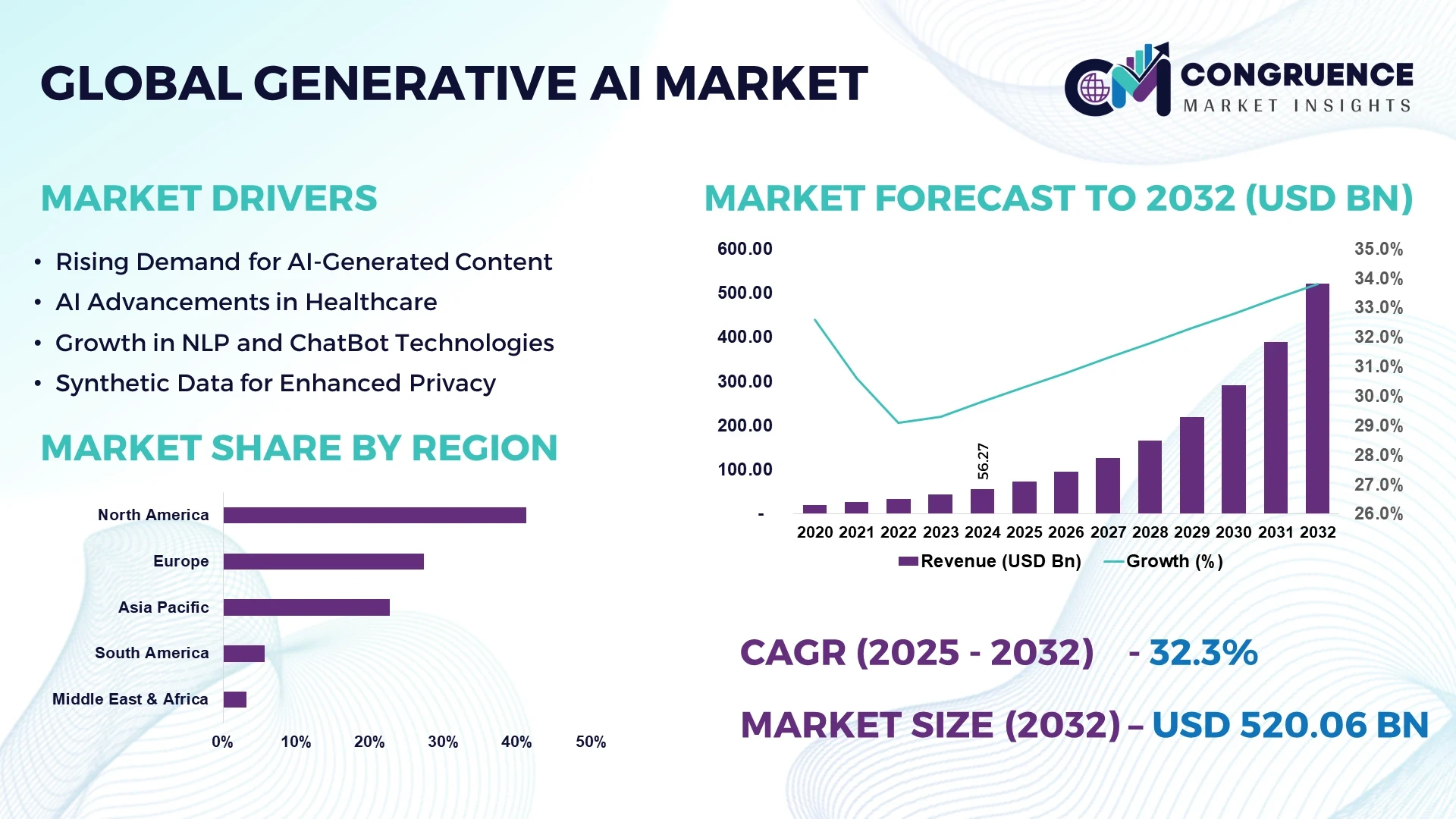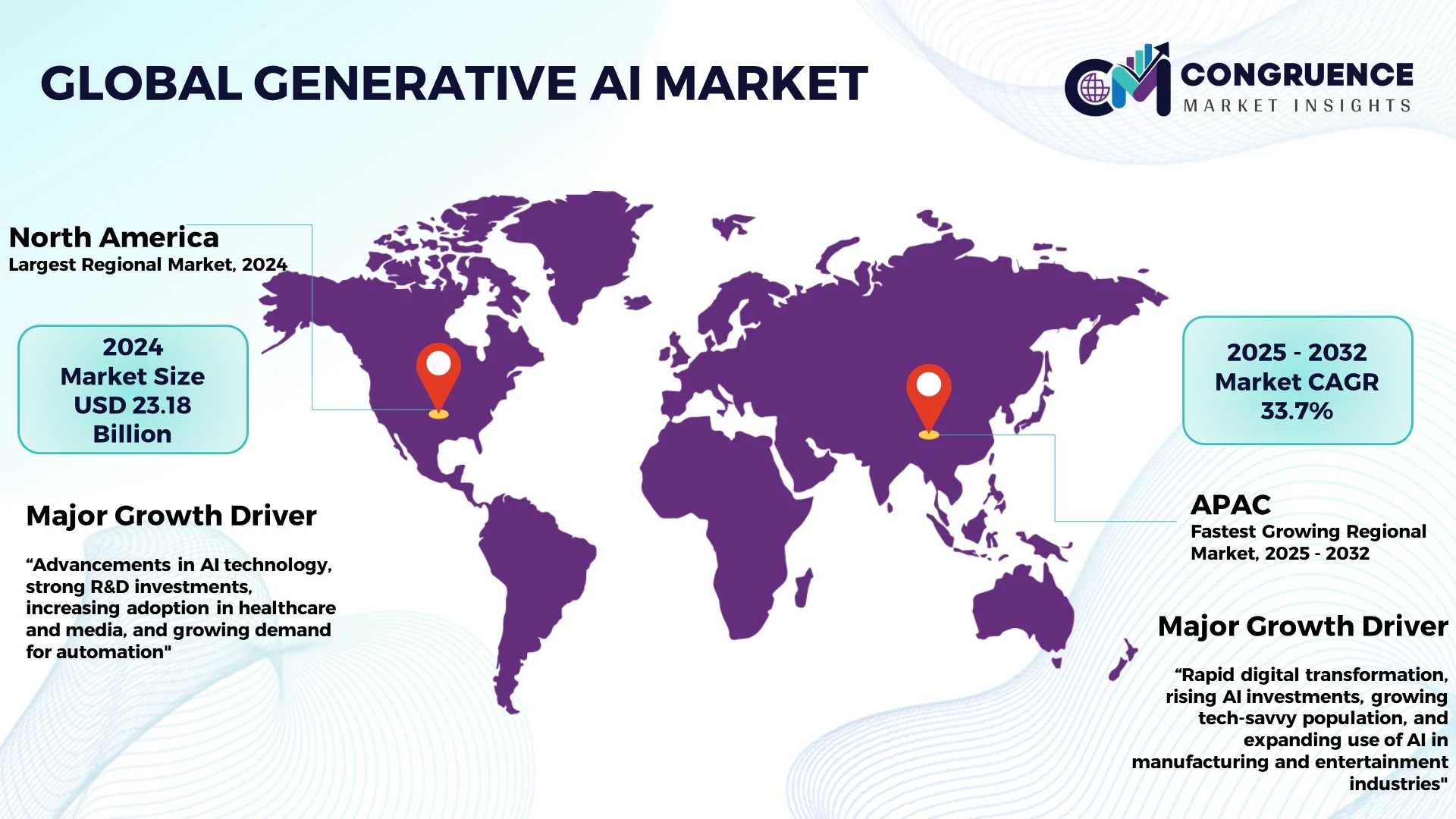Reports
Generative AI Market Size and Forecast 2025 to 2032
The Global Generative AI Market was valued at USD 56.27 Billion in 2024 and is anticipated to reach a value of USD 520.06 Billion by 2032 expanding at a CAGR of 32.3% between 2025 and 2032.

To Learn More About This Report, Request A Free Sample Copy
Generative AI is changing businesses by automating the development of new material, such as photos, writing, and designs, using machine learning models. With significant advancements in neural networks, AI is no longer restricted to data analysis, but can also develop new, contextually relevant outputs based on learnt patterns. The market's exponential expansion is being driven by reasons such as increased demand for AI-generated content in the media, increased usage of synthetic data in various industries, and advances in drug discovery methods. Companies from a variety of industries, including retail, healthcare, and finance, are implementing generative AI to increase productivity and save operational costs. Furthermore, advancements in natural language processing (NLP), image synthesis, and AI-driven automation are contributing to the market's rapid rise. Generative AI's uses go beyond typical AI, improving creative processes, enabling tailored services, and opening up new paths for industry innovation.
This rapid rise in the market is also being driven by advances in deep learning, increased demand for automated content creation, and the widespread deployment of AI across different industries. Generative AI technologies are increasingly being used in a variety of industries, including healthcare and media, to boost creativity, automation, and efficiency.
How AI is Transforming Generative AI Market
AI's impact on the Generative AI business is significant. AI models, particularly deep learning algorithms, are always growing to become more proficient at producing content that reflects human creativity. Generative AI is transforming content creation by generating text, images, audio, and even 3D models that would otherwise require human intervention. For example, AI-powered text generation models such as GPTs are commonly employed in writing helpers, while Generative Adversarial Networks (GANs) improve image and video editing skills.
AI-powered generative models in healthcare are outpacing traditional methods in terms of drug discovery, synthetic compound creation, and possible therapy modeling. AI's capacity to generate synthetic data is proving invaluable in fields where data privacy is critical, allowing organizations to create realistic datasets without jeopardizing sensitive information. Furthermore, generative AI is being used in gaming and entertainment, allowing the creation of immersive, AI-generated game content, stories, and characters. As AI improves, generative models' efficiency and capacities are predicted to increase, revolutionizing industries by delivering scalable solutions for creative and analytical activities.
Generative AI Market Major Driving Forces
· Rising Demand for AI-Generated Content: The media and entertainment sectors are increasingly using generative AI to create automated content, such as text, music, and graphics. The capacity to automate creative processes contributes to the increased need for tailored and real-time content creation.
· AI Advancements in Healthcare: Generative AI is accelerating drug discovery, creating synthetic medical data for research, and contributing in the development of new diagnostic tools. These advancements are encouraging healthcare providers to invest in AI technology.
· Growth in NLP and ChatBot Technologies: The rise of conversational AI and improved natural language processing has accelerated the use of generative AI to create human-like chatbots and virtual assistants for customer support, decreasing human intervention and increasing efficiency.
· Synthetic Data for Enhanced Privacy: As companies seek to comply with severe data privacy rules, generative AI's capacity to generate realistic yet anonymised synthetic data is becoming increasingly important, notably in banking, healthcare, and retail.
Generative AI Market Key Opportunities
· Automated Content Creation in Media: The desire for AI-powered content generating tools in the entertainment business presents a significant opportunity for generative AI to challenge existing production methods.
· Personalized Marketing Solutions: Businesses are looking to use generative AI to create highly personalized marketing content for customers, potentially opening up new opportunities in AI-driven advertising and ecommerce.
· AI in medication Discovery: Generative AI's capacity to model chemical compounds and predict their effects has the potential to transform medication discovery, allowing pharmaceutical companies to lower costs and accelerate time-to-market.
· Expansion of AI-Powered Design Tools: AI is also revolutionizing industries such as architecture and fashion, where generative AI can automate the design process and produce complex designs and simulations on a large scale.
Generative AI Market Key Trends
· Advances in Transformer Models Generative Pretrained Transformers (GPTs) are increasingly being used in a variety of applications, including content generation and conversational agents, resulting in higher-quality outputs.
· As privacy restrictions tighten, businesses are using generative AI to produce synthetic datasets that mirror real-world circumstances while ensuring data privacy and compliance.
· Artists and content creators are employing AI models to collaborate on creative works, which is gaining popularity in digital art, music, and narrative.
· In gaming and simulation, generative AI improves user experiences by creating complex settings and scenarios in real time, resulting in a more participatory and immersive experience.
Region-wise Market Insights
North America accounted for the largest market share at 41.2% in 2024 whereas, Asia Pacific is expected to register the fastest growth, expanding at a CAGR of 33.7% between 2025 and 2032.

To Learn More About This Report, Request A Free Sample Copy
North America dominated the global market in 2024, with a 41.2% share valued at USD 23.18 billion, and continues to do so because to the existence of significant players such as OpenAI and Google. The region's superior infrastructure and significant investments in AI research and development are crucial factors. The United States has the highest share, driven by demand in industries such as entertainment, healthcare, and retail.
· In February 2025, OpenAI shared its roadmap for GPT-4.5 and GPT-5 models, emphasizing improvements in general AI capabilities, user safety, and ethical use. These future models are expected to bring advanced reasoning, deeper context understanding, and better integration into everyday applications. OpenAI also stressed its commitment to making AI tools more responsible, transparent, and user-friendly.
The Asia Pacific region is predicted to develop the quickest, with a CAGR of 33.7% from 2025 to 2032. Countries such as China, Japan, and South Korea are investing heavily in AI, utilizing generative technology in areas such as manufacturing, telecommunications, and content creation.
Europe's emphasis on data protection and security has fueled the development of AI solutions that adhere to demanding regulatory norms, particularly in the BFSI and healthcare industries. Meanwhile, Latin America and Africa are gradually catching up with investments in generative AI technologies, notably in the financial and retail industries.
Recent Developments
· In January 2025, NTT DATA announced its AI-centric customer service platform that integrates generative AI with Chabot capabilities to enhance client support operations. The solution focuses on improving response times, scalability, and customer engagement through real-time data analysis and tailored interactions. The platform is designed to support various industries by offering seamless integration with existing CRM systems.
· In December 2024, Google DeepMind updated on its Gemini AI system, showcasing advanced capabilities in reasoning, planning, and multimodal integration. The update emphasized improvements in AI-generated text, image understanding, and context-based applications, further enhancing Google's AI products.
· In November 2024, Microsoft introduced new Adapted AI models tailored for specific industries, including manufacturing, healthcare, and retail. These models focus on enhancing operational efficiency, decision-making, and security through AI-powered tools. Microsoft highlighted the integration of these models within Azure and its use of advanced machine learning techniques to optimize processes across various sectors.
Market Competition Landscape
The Generative AI industry is highly competitive, owing to significant advances in artificial intelligence and machine learning technology. OpenAI, Google DeepMind, Microsoft, and Anthropic are among the field's leading participants, boasting advanced models such as massive language models and image generating systems. These firms invest extensively in research and development to improve AI skills and broaden their applications in fields such as healthcare, banking, and content creation. Startups like as Cohere and Jasper AI are gaining headway by providing specialist solutions, while cloud providers like Amazon Web Services (AWS) and IBM provide infrastructure for AI implementation. Competitive pressures are rising as new entrants arise, driving innovation and advocating for better accessibility and ethical AI use. Partnerships, acquisitions, and strategic alliances are prominent strategies for gaining market dominance, but regulatory frameworks and responsible AI development continue to shape competition in the generative AI ecosystem.
Key players in the global generative AI market implement various organic and inorganic strategies to strengthen and improve their market positioning. Prominent players in the market include:
· OpenAI
· Google DeepMind
· Microsoft Azure
· Amazon Web Services (AWS)
· IBM Watson
· NVIDIA Corporation
· Adobe Inc.
· Salesforce
· Baidu
· Alibaba Cloud
· Hugging Face
· Cohere
· Synthesia
· Runway ML
|
Report Attribute/Metric |
Details |
|
Market Revenue in 2024 |
USD 56.27 Billion |
|
Market Revenue in 2032 |
USD 520.06 Billion |
|
CAGR (2025 – 2032) |
32.3% |
|
Base Year |
2024 |
|
Forecast Period |
2025 – 2032 |
|
Historical Data |
2020 to 2024 |
|
Forecast Unit |
Value (US$ Bn) |
|
Key Report Deliverable |
Revenue Forecast, Growth Trends, Market Dynamics, Segmental Overview, Regional and Country-wise Analysis, Competition Landscape |
|
Segments Covered |
· By Component (Software, Services, and Hardware) · By Technology (Deep Learning, Reinforcement Learning, Transfer Learning, and Supervised Learning) · By Type (Generative Pretrained Transformers (GPT), Diffusion Models, Generative Adversarial Networks (GANs), and Autoencoders) · By Application (Content Creation, Data Augmentation, Drug Discovery, Synthetic Data, and AI-based Gaming) · By End-Use Industry (Media & Entertainment, Healthcare, BFSI, Retail, and Manufacturing) |
|
Geographies Covered |
North America: U.S., Canada and Mexico Europe: Germany, France, U.K., Italy, Spain, and Rest of Europe Asia Pacific: China, India, Japan, South Korea, Southeast Asia, and Rest of Asia Pacific South America: Brazil, Argentina, and Rest of Latin America Middle East & Africa: GCC Countries, South Africa, and Rest of Middle East & Africa |
|
Key Players Analyzed |
OpenAI, Google DeepMind, Microsoft Azure, Amazon Web Services (AWS), IBM Watson, NVIDIA Corporation, Adobe Inc., Salesforce, Baidu, Alibaba Cloud, Hugging Face, Cohere, Synthesia, Runway ML |
|
Customization & Pricing |
Available on Request (10% Customization is Free) |
